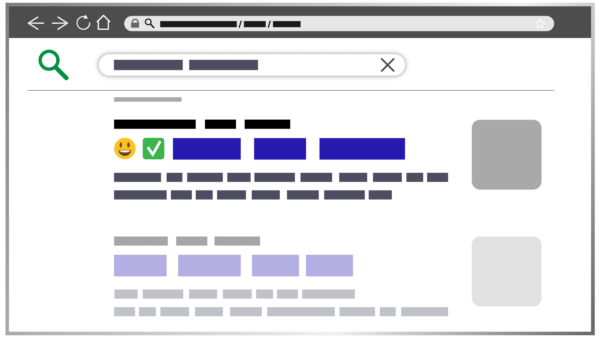How to use emojis in your page title and meta description💡

With the rise of social media and smartphone adoption, emojis have gone from cute icons we add to our text messages to becoming an integral part of our day-to-day communication. For many people, emojis belong to social media and text messages, as we mostly use them in these contexts. But did you know that you can also add emojis to your web page’s title and meta description? In this post, we’ll explore the why and how of using emojis in titles and meta descriptions. At the same time, we’ll discuss some precautions and nuances of using them in SEO.

The emojis phenomenon 😍
We’ve become so familiar with using emojis in online communication that it’s hard to think of a world without them. In fact, we love emojis so much that ‘face with tears of joy’ was selected as Oxford Dictionaries 2015 Word of the Year. Technically speaking, that’s an emoji (this one: 🤣) and not a word.
That’s all thanks to the rich and expressive nature of emojis, especially when you compare them to text. Those little, colorful icons can represent such a wide variety of things – from faces to sports, to food, and many other things. We use them as a tool, a means of communication to express our feelings and emotions. Other times, we use them to quickly replace a whole phrase or even a complete sentence.
Since texting and social media interactions are short forms of communication, it makes sense that people want to make their communication brief and simple. Not to mention, emojis are fun to use and fun to look at. It makes you engage with the people you’re chatting with, or with the content on your social media feed.
Why use emojis in page titles and meta descriptions?🤔
Did you know that search engines support search queries with emojis? Try doing a search by adding a donut emoji and the name of the city where you live. You will likely see a search result page with bakeries and restaurants selling donuts. You might even see emojis in the title or meta descriptions of some results.
Google stated that adding emojis to titles and meta descriptions is allowed, but they have no direct effect on SEO. That means you can use them at your own will, but don’t expect a ranking boost.
So, using emojis won’t directly affect your ranking. But they can indirectly help with SEO by influencing the click-through rate of your search results. As mentioned above, emojis are colorful and fun to look at. That makes them stand out immediately in the search result page where most of the information is displayed in text.
You can play with the dynamic of emojis and use them as a way to grab the attention of searchers, motivating them to click on your results instead of your competitors. This helps to improve your organic click-through rate, which is a good thing as it may impact your search rankings as well.

Is there data to back this up?
It’s important to note that the hypothesis of emojis increasing click-through rate is not conclusive yet. Although some SEO experts believe in this, there’s not enough conclusive data to back it up. There have been small-scale experiments done on this topic, though.
For instance, SplitSignal did their own split test by adding a cocktail-like emoji to the title of their recipe pages. At the end of the test, they saw an increase of 11.3% in organic traffic, which is quite a lot. On the other hand, Searchpilot also ran a similar split test in which they replaced the numbers in a website’s category page meta descriptions with the equivalent numerical emojis. For them, they actually saw a drop in organic traffic for the variant pages compared to their expected performance.
Since these two experiments were done independently and with a small sample size, it’s impossible to say if one result is more conclusive than the other. At the same time, they had very different websites, target groups, and research methodologies.
Our advice for using emojis
As you can imagine, we can’t say for sure that using emojis guarantees an increase in clicks for your web pages. It’s more about having a hypothesis and testing it out. However, if you’re looking to add emojis to your page title and meta description, we do want to give some recommendations as follows.
🟢First, always take account of your business and the niche/industry you’re in. It’s without a doubt that emojis work better for some niches and industries than others. Let’s say your company is in the health care industry, dealing with the safety and wellbeing of others. Usually, you would want people to see your brand as being helpful and trustworthy. In this case, would adding emojis to your page titles help or hurt your brand reputation? On the other hand, if you’ve just opened a local cafe with a hip vibe, it’s not a bad idea to tailor some pages and add one or two emojis to drive clicks to your website.
🟢Second, take your audience into consideration and decide if emojis may resonate well with them or not. For instance, if the majority of your visitors are teenagers and young adults, then they might be drawn in by these colorful icons.
🟢Third, use emojis sparingly and in moderation. And don’t add emojis to every page title and meta description. Having one or two emojis in either your page title or meta description is more than enough to capture the attention of searchers. Overdo this and your search results may appear spammy, which may discourage people from clicking on them.
🟢Last but not least, use the right emojis for your brand and your audience. Emojis are rich in meaning, but that means people can easily misinterpret them, especially when used in the wrong context.
Some more precautions regarding emojis in titles and meta descriptions 🟠
Other than the recommendations we give above, you should know that there are some precautions and nuances to using emojis in page titles and meta descriptions, including:
- How emojis are displayed is heavily dependent on the font, the device, and the browser searchers use. That means the same emojis may look different on mobile versus on desktop. In some cases, the same emojis may not be displayed on certain devices and browsers set up. Or worse, the same emojis may appear as blank squares because they are not supported.
- Google and other search engines may drop support for emojis in the search result page. If that happens, all your work will be gone, and searchers are left with weird code and blank squares. Actually, Google did this once in 2015, but the company changed its stance and resumed support afterward.
- Generally speaking, there’s no limit to the length of meta descriptions. But Google only displays up to 155 characters in the search snippets. At the same time, emojis may take up more characters than text, so you need to take this into consideration.
- Google’s algorithm is already rewriting a lot of titles and meta descriptions, to begin with. So even if you add emojis, Google might not display them in the search result page.
- Too many emojis can be a bad thing for accessibility. Particularly for people using screen readers, as illustrated in this tweet.
Easily add emojis with Yoast SEO Premium 🙌
Now that you’ve got enough information about the use of emojis in titles and meta descriptions, let’s talk about how to actually add them there. Back in the day, you would need to dive into the HTML of your web page and edit codes. It’s not too complicated to do so, but it would still be time-consuming and inconvenient, especially for those who are not savvy about HTML.
Fortunately, Yoast SEO Premium makes it quick and simple with the new emoji picker tool. The best part is that you won’t have to fiddle with codes to make it work.
All you need to do is choose the place where you want to add emojis, click on the smiley face and choose from a large library of emojis. From here, you can also preview how your content will appear in the search result. That’s it, nice and simple, right? 😁.

Final thoughts
Emojis are fun, colorful, and expressive. They can be utilized to attract attention in the search result page, resulting in more clicks and visits to your site. However, the usefulness of emojis depends on many factors, such as your business and your audience. There’s no guarantee that they will positively impact your organic traffic, so do consider if emojis are right for your website, run tests with them, and use them in moderation.
Should you want to add emojis to your page titles and meta descriptions, why not consider using the emoji picker tool in Yoast SEO Premium? It’s quick, simple, and easy to use. The best thing about it is that you won’t have to fiddle with codes just to add a simple smiley face to your page title. Check it out!

